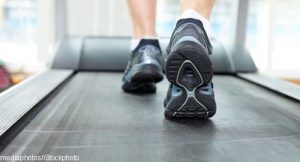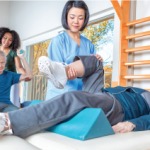 Editor’s note: ACR on Air, the official podcast of the ACR, dives into topics important to the rheumatology community, such as the latest research, solutions for practice management issues, legislative policies, patient care and more. Twice a month, host Jonathan Hausmann, MD, a pediatric and adult rheumatologist in Boston, interviews healthcare professionals and clinicians on the rheumatology front lines. In a series for The Rheumatologist, we provide highlights from these relevant conversations. Listen to the podcast online at acronair.org, or download and subscribe to ACR on Air wherever you get your podcasts. Here we highlight episode 30, Importance of Physical Activity for People with Rheumatic Diseases, which aired on June 7, 2022.
Editor’s note: ACR on Air, the official podcast of the ACR, dives into topics important to the rheumatology community, such as the latest research, solutions for practice management issues, legislative policies, patient care and more. Twice a month, host Jonathan Hausmann, MD, a pediatric and adult rheumatologist in Boston, interviews healthcare professionals and clinicians on the rheumatology front lines. In a series for The Rheumatologist, we provide highlights from these relevant conversations. Listen to the podcast online at acronair.org, or download and subscribe to ACR on Air wherever you get your podcasts. Here we highlight episode 30, Importance of Physical Activity for People with Rheumatic Diseases, which aired on June 7, 2022.
Rheumatologists know that physical activity is essential for their patients. The challenge can be finding the exercise that works best for that patient and getting them started. That’s where professionals in both physical therapy (PT) and occupational therapy (OT) can help.
Dr. Hausmann, ACR on Air podcast host and a pediatric and adult rheumatologist in Boston, discussed physical activity for people with rheumatic diseases with Kim Steinbarger, PT, MHS, DHSc, and Talitha Black. Dr. Steinbarger is a physical therapist and assistant professor at Husson University, Bangor, Maine. She chairs the ARP Practice Committee and is a member of the ARP Executive Committee. Dr. Steinbarger has also lived with rheumatoid arthritis for more than 30 years. Ms. Black is an occupational therapist at Children’s Hospital Los Angeles, as well as a patient educator and advocate for the Arthritis Foundation, Scleroderma Foundation and the ARP.
A Helping Hand to Get Started
Starting and maintaining physical activity may pose challenges for children and adults with rheumatic diseases due to pre-existing pain. Dr. Hausmann says, “When patients see me in clinic, the last thing they want to do is exercise because their joints hurt.”
That’s actually the perfect time to refer patients to PT and OT, Dr. Steinbarger notes. “We can walk through their life with them and figure out where they can fit that physical activity into their lives,” she says.
Physical therapists are movement specialists who study joints, muscles, strength and range to help assess how to make those better. Occupational therapists help patients with everyday activities, such as dressing, showering and making dinner. They also help integrate physical activity into daily schedules and routines. Hand skills are within the domain of OT and sometimes PT.
When to Refer
The (JIA) conditionally recommends PT and OT in addition to concomitant pharmacologic therapy.1 But some children with JIA may already exercise a lot or don’t have major joint issues, leading Dr. Hausmann to ask when to refer these patients to PT or OT.
Ms. Black advises rheumatologists to refer to OT if there’s a new JIA diagnosis and a child has joint symptoms that are or may get in the way of function. That way, the therapist can evaluate and decide if ongoing therapy is needed. An evaluation is important even in young children who are trying to meet developmental milestones.
Ms. Black shares the example of a 12- to 18-month-old child with a swollen knee learning to walk. She says, “It would be even more important for [this patient] to be referred to therapy so that they can work on that knee and walk at the right time.”
For adults, a referral to PT and OT should occur as soon as they receive a diagnosis of rheumatic disease, says Dr. Steinbarger. She acknowledges that approach may be “pie in the sky.”
“Even if at that point, [the patient is] not having a specific hot joint or anything like that, there are a lot of things they need education on,” she says. These things may include figuring out the appropriate physical activity when they have a flare.
For PT and OT, specialists will evaluate and discuss goals with patients related to physical activity. Often, reaching those goals involves adapting and remediating treatment plans as needed.
Baby Steps
In adults, Dr. Steinbarger says current federal guidelines—30 minutes of activity, five days a week, along with strengthening exercises—can feel overwhelming to someone with rheumatic disease.
Dr. Steinbarger tries to be as specific as possible to get patients with rheumatic diseases started with physical activity to avoid feeling overwhelmed. Often, achieving this starts with baby steps: discuss specifics, focus on physical activity over such messages as “You must go to the gym” and acknowledge that fatigue is a real factor.
Often, she recommends aerobic exercises, such as walking, swimming, housework or gardening as a starting point. She emphasizes the importance of movement to help stave off an increased risk for cardiac problems.
If a patient has osteoarthritis or other joint limitations, Dr. Steinbarger focuses on lower-impact activities, including biking, swimming and walking.
These recommendations also involve making patients aware of what they’re already doing. Dr. Steinbarger had a patient who quilts and claimed she didn’t exercise much. Through more conversation, the patient revealed that she used a large quilting machine in her garage that she often walks around.
“We put a pedometer on her, and it was amazing how much physical activity she was getting. But if I hadn’t asked, I wouldn’t have known,” Dr. Steinbarger says.
One issue that comes up with children with JIA is encouraging them to continue to be active in classes, such as PE—even if parents wonder if they can be excused. Occupational therapists may recommend patients’ parents work with their school to create a 504 plan, which enables schools and teachers to remove barriers from learning for students with disabilities. In the case of a child with JIA, this may include accommodations, such as a tailored plan for PE so they still have activities they can do. Because JIA is not a common condition, there is sometimes pushback from PE teachers regarding accommodations, Ms. Black says.
Exercise Through Pain?
Both Ms. Black and Dr. Steinbarger acknowledge the role pain plays in physical activity when a patient has rheumatic disease. Dr. Hausmann asked when should a patient push through pain and when should they not?
If it’s new pain, it’s crucial to attend to and try to figure out the cause, Ms. Black says. This pain differs from the soreness patients experience when they first start exercising, which can be a “good” pain.
For centralized pain, specialists in OT and PT can help address the pain with movement and other cognitive strategies. Part of that is teaching patients the difference between pain related to injured tissues and pain for which there’s no physical injury, Dr. Steinbarger notes.
Misconceptions
Dr. Steinbarger and Ms. Black shared two common questions patients with rheumatic disease have about physical activity . One of these is whether it’s OK to exercise if there’s a flare. Dr. Steinbarger says physical activity should continue, although the kind of movement may differ.
“You can’t stop moving. You’re just going to move differently. There should be a plan for that,” she says. “You can make that plan with your physical therapist or OT.”
On the pediatric side is the misconception that kids with arthritis can’t or shouldn’t do sports. Ms. Black notes that most of them can so long as they avoid contact sports, such as football or boxing. She adds that there may need to be some adaptations and allowances for rest breaks.
Vanessa Caceres is a medical writer in Bradenton, Fla.
Reference
- Onel KB, Horton DB, Lovel DJ, et al. 2021 American College of Rheumatology Guideline for the treatment of juvenile idiopathic arthritis: recommendations for nonpharmacologic therapies, medication monitoring, immunizations and imaging. Arthritis Rheum. 2022 Apr;74(4)570–585.
More Episodes
A new episode of ACR on Air comes out twice a month. Listen to this full episode and others online at acronair.org. Or download and subscribe wherever you get your podcasts.


